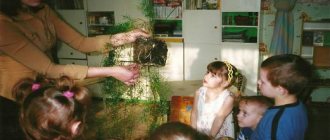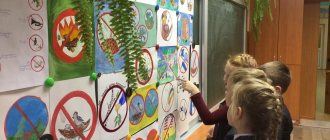Methodological development “Methods of environmental education of preschool children”
The next verbal method is reading works of fiction.
In the hands of a teacher, a children's book about nature has great educational value. It expands children's understanding and introduces them to phenomena that are impossible to directly perceive. A natural history book reveals to children the phenomena of inanimate nature, helps to establish connections and relationships that exist in nature.
The founders of Soviet children's natural history books are V.V. Bianchi, M.M. Prishvin, Paustovsky, Sladkov. Pavlova introduced a new genre - environmental fairy tales, which in a fascinating way introduce the creatures inhabiting planet Earth, teach us to understand their needs and relationships, and reveal the secrets of complex phenomena and miraculous transformations in nature. The ecological fairy tale was further developed by Shorygina and Ryzhova.
Practical methods.
One of the practical methods of environmental education is play.
While playing, children learn about the natural environment, their knowledge about objects, objects, and natural phenomena noticeably expands and becomes more specific.
Play activities also have an impact on the development of children’s humane feelings towards nature and their cognitive attitude towards it.
A special place and importance in the system of environmental education for preschoolers is occupied by didactic, that is, educational games.
Didactic games are games with ready-made content and rules. In the process of didactic play, children clarify, specify, consolidate, expand, and systematize their ideas about nature. At the same time, the didactic game influences the development of preschoolers’ mental operations (such as analysis, synthesis, comparison, generalization, classification, etc.)
In the process of environmental education of preschoolers, the following types of didactic games are used:
subject;
desktop-printed;
verbal;
creative.
Didactic games should be used starting from the younger age group.
Creative games are of great importance in the system of classes with children on environmental topics.
Construction games with natural materials
(sand, water, clay, cones, pebbles, etc.). They have a positive impact on the process of children learning specific properties and qualities of natural objects. In the process of these games, children’s sensory experience is enriched, improved, and cognitive abilities are developed. Construction games can also be used to prepare children for practical research activities, since during these games children often learn problem situations related to the physical properties of materials (for example, why dry sand crumbles, but wet sand can be used to make Easter cakes).
What is S.N. Nikolaeva’s book about on methods of educating preschoolers about ecology?
Svetlana Nikolaevna Nikolaeva is a Doctor of Pedagogical Sciences, chief researcher at the Institute of Psychology, dealing with childhood problems. The author of scientific works on pedagogy is known for her research related to environmental education. She reveals this topic in her work “Methods of environmental education of preschool children.”
Palms holding children and rainbow
The textbook was written by a person with extensive experience in raising children. According to Nikolaeva S.N., environmental education should begin with stories about nature. And when the child’s consciousness is filled with the necessary information, it is possible to consolidate in the pupil a certain attitude towards the environment:
- educational;
- aesthetic;
- humanistic.
Important! Nikolaeva S.N. “Methods of environmental education of preschool children” is a work in which the author expresses confidence: a person’s attitude to the natural environment is an indicator that shows how educated he is in environmental terms. And it is important to start such education as early as possible, from the preparatory group of kindergarten, consolidating it in the middle and senior groups.
The teacher proposes a method of environmental education, which consists of two main points:
- transfer knowledge on ecology;
- modify them into relationships.
Environmental education of Nikolaeva’s preschoolers should be about achieving the final result when the child consciously treats nature with care. Realizing that he too is part of this environment.
Planet with a butterfly in human palms
Application to the program
To successfully implement this goal, Svetlana Nikolaevna has developed a special program. This is “Young Ecologist” for Nikolaeva’s preparatory group.
This manual examines the issue of environmental education and culture of children in preschool age. The basis of the book consists of theoretical and practical research on this topic. The author devoted several decades to this work.
Note! Tentatively, the readers of the book should be practitioners involved in preschool education, teachers and students of pedagogical institutes and pedagogical colleges.
The “Young Ecologist” application provides for the study of the following topics:
- Plants, animals and humans live among living and inanimate nature.
- Plants and animals are diverse, they are united by their habitat.
- Plants and animals grow and develop in their environment.
- Man constantly interacts with nature.
Didactic game on the topic of ecology in senior groups of preschool educational institutions
For which kindergarten groups is this book suitable?
Ecological culture in a kindergarten should be instilled by the teacher. Therefore, it is important for him to understand the significance of environmental problems and the reasons that gave rise to them. This technique was developed for children starting from junior kindergarten age - the preparatory group.
“The Theory and Methods of Environmental Education for Children” by Nikolaeva S.N. is intended specifically for the youngest pupils of a kindergarten, since even then children can learn important information:
- how plant and animal organisms and habitats are related;
- how diverse are living organisms that are in ecological unity;
- what communities do living organisms unite into?
- a person is a living being, in his habitat he receives all the conditions for healthy and normal, high-quality life;
- people use natural resources, but at the same time pollute the environment;
- it is important to protect and restore natural resources;
- The end result of the implementation of the methodology should be a conscious, careful attitude towards the environment.
Important! The main aspects of the program are as follows: the end result of environmental education work is attitude. The teacher is assigned the role of a carrier of ecological culture.
A teacher and children from a kindergarten group during a lesson
Forms of environmental education
- Lesson . The most basic and most common form of work on environmental education of children is the lesson. He also classes (GCD) in kindergartens. In support of environmental education, such a subject as the surrounding world was created, which introduces children to living and inanimate nature, its laws, and the basics of environmental protection.
Lessons (activities) allow the teacher to develop children's knowledge about nature, taking into account their age characteristics. There are several types of classes:
- Initial informational. Such lessons (lessons) have an introductory function, that is, they introduce children to certain species (animals, birds, fish, etc.), their living conditions, natural phenomena, and basic concepts about the environment. The necessary material for such activities (lessons, conversations) are visual materials (demonstration aids, posters, films);
- Generalizing. Allows children to form general concepts about certain types and natural phenomena, the ability to identify their common features (senior preschool and primary school age);
- In-depth cognitive. Classes (lessons) that are based on previously acquired knowledge. Deepening what has already been learned, applying it in practice - such lessons are conducted in the form of a conversation, a quiz, or watching a video in class.
- Ecological holidays. Activities that are classified as extracurricular activities. They can be either timed to coincide with calendar holidays (Earth Day), or independent, invented by teachers. The purpose of such leisure is to evoke a positive emotional response in children, which in turn awakens interest in environmental problems. When drawing up an entertainment script, material that is already familiar to children is used.
- Excursions . Starting from the middle group of a preschool educational institution and ending with the middle classes of a comprehensive school, an excursion is one of the most effective forms of work on environmental education of children. And this is understandable. No matter how much we talk, no matter how many conversations we have, nature is an environment that can only be experienced by coming into direct contact with it, in a natural setting. The teacher conducts excursions in accordance with the requirements of the state educational program, previously indicating goals and objectives in the calendar plans.
- Labor It would be strange not to indicate this form of direct combination of human activity with environmental protection. In kindergartens, this is caring for living corners, flower beds, small vegetable gardens, organized by educators for the purpose of environmental education of children. At school, this means cleaning the area, watering, caring for plants, and working on the school site (especially common in rural schools).
- Participation in school city competitions and olympiads. Such competitions are often held both by the schools themselves to strengthen motivation among students, and by the city administration. Site reviews, quizzes, olympiads - all this awakens the spirit of competition, and, as a result, provides significant motivation for environmentally oriented detail among children of primary and senior school age.
- Working with parents. A full educational effect is achieved when school and family act in the same direction. Therefore, working with parents is one of the most important forms of environmental education. Consultations for parents, participation in school events, experiments conducted by children together with their parents (at home, in the country, in the village), participation of parents in shows and exhibitions are techniques that are necessary for fruitful work.
Environmental education at school taking into account the Federal State Educational Standard
Visual methods
Observation is a purposeful, systematic perception of objects and phenomena of the surrounding world. This is a complex cognitive activity that involves perception, thinking and speech and requires sustained attention. In understanding the observed phenomenon, the experience, knowledge and skills of the child are essential.
By organizing observations in nature, the teacher solves a number of problems in a complex:
- Forms children's knowledge about nature.
- Teaches you to observe.
- Develops observation skills.
- Develops aesthetic feelings.
Depending on the cognitive tasks, the teacher uses various types of observation. Based on the content, observations are conventionally divided into two types: natural history - in a park, forest, river, meadow, etc., as well as in a zoo, botanical garden (they are carried out in different seasons); observations of agricultural objects - in the field, at a poultry farm, in a garden, vegetable garden, etc. in order to familiarize themselves with the work of adults. To successfully achieve the goal, the teacher thinks through and uses special techniques that organize the active perception of children: asks questions, offers to examine, compare objects with each other, establish connections between individual objects and natural phenomena. The inclusion of various senses in the process of observation ensures the completeness and specificity of the knowledge being formed. Observation must be accompanied by precise speech from the teacher and children so that the acquired knowledge is assimilated. Since observation requires concentrated voluntary attention, the teacher must regulate it in time, volume and content.
The systematic use of observation in getting to know nature teaches children to look closely, notice its features and leads to the development of observation, and therefore the solution of one of the important tasks of mental education.
Observation can be carried out both with individual children, with small groups, and with the entire group of pupils. Depending on the goals set by the teacher, observation can be episodic, long-term and final (generalizing).
The teacher's preparation for observation begins with the selection of an object. If an animal is observed, it is necessary to create an environment in which the animal behaves freely and naturally. For example: when observing a rabbit, a fairly spacious pen is built for it, around which children are placed on chairs. A rug should be placed on the floor, otherwise the animal will slide on the smooth floor. In order to arouse interest, an emotional attitude to observation, and ensure an aesthetic perception of objects, the teacher uses poetry, small forms of folklore when working with children, and with older children, during the lesson, also reading excerpts from works of art. observation must proceed in a certain sequence. Using various techniques for presenting a task, the teacher accustoms children to a consistent story about what they observe: the size, shape of an object, cover, color, peripheral parts and their features, and when observing an animal, its behavior. This order is necessary especially when children get acquainted with a new object.






